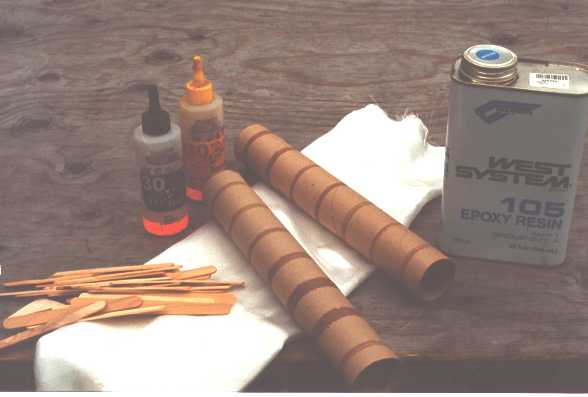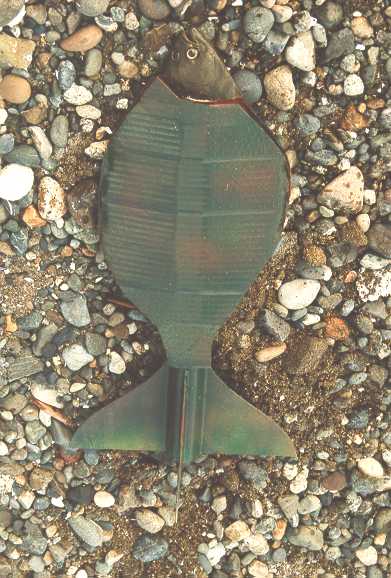| Manufacturer: | Scratch |
Flounder Parts, the Rocket
 I place the blame for the flounder
squarely on Bob Fortune's shoulders. He named the contest "flounder
parts". What was I supposed to do?
I place the blame for the flounder
squarely on Bob Fortune's shoulders. He named the contest "flounder
parts". What was I supposed to do?
I've had this old flounder head laying around for many years. I'm not sure where I got it, I just remember coming back from Canada with it. It was a fishing trip to Uklulet, up in British Columbia. I remember fishing, drinking, sleeping on a big boat, drinking, and coming home with this fish head glued to the brim of my hat.
The project:
I wanted to make the rocket
look as much like a flounder as I could. The first shape looked great
but wasn't very stable. In fact, it was scary with an E18-4 in it!
So, I trimmed it down a bit, added 4oz of nose weight, and filled the area
between the side fins with great stuff foam. It fly's fine now.
The rocksim file is close. It won't allow for (that I could tell)
only two fins up front, so I simmed it with both 3 and 4.
The body tube is made of two Reynolds wrap cardboard rolls with two layers of light (4oz ?) glass. It had to be tough because I knew it would need some considerable nose weight and it might crash a time or two on test flights. The fins are cut from 1/8 light ply, surface mounted with epoxy to the BT. The nose cone is a cast urethane fish head, complete with eyeballs and half open mouth. I made the shoulder out of a chunk of balsa turned round on my 3/8 hand held drill.
Materials:

BT - (2) aluminum foil wrap
rolls 11 inches long each. 1.6 in dia
19.75 inches long (trimmed
ends after glassing)
Fins - (4) 1/8 hobby light ply
MMT - hand rolled from cereal box cardboard. About 4 inches long, 2 wraps.
Nose cone - Fish head bonded with epoxy to 1 inch long balsa shoulder.
Chute - 12 inch nylon
Shock cord - 1/2 inch braided elastic strap, 16 inches long
Nose weight - 4oz (about 12 inches) of 1/4 inch dia lead.
eye bolt - 1/2 inch eye hole, 1 inch wood screw type threaded shaft
launch lug - 6 inch long 1/4 dia thin wall brass tube
 Construction:
Construction:
The motor mount is simply a
few wraps of cardboard from a cheerios box wrapped around a spent G55,
bonded together (not to the motor) with yellow glue. The centering
rings (4) are cut from corregated cardboard. I used epoxy to bond
them, filling the open corregations before sliding them in.
The recovery system is basic model rocket type stuff; a 1/2 inch wide length of elastic band and a nylon parachute scavenged from a military flare. A large eyebolt (1/2 inch eye) in the nosecone shoulder attaches the shock cord as well as serves as an anchor for the 4oz nose weight. I use 1/4 inch dia lead rope for nose weights. We use it up here in the northwest for fishing in the rivers. An inch or two of it is slipped in a surgical rubber sleeve. If it becomes snagged, the weight pulls out and the rest of the rig is saved. On the flounder I simply wrapped it tightly around the eyebolt.
Launch Report:
We had beautiful weather Sunday the 6th. Our regularly scheduled club launch was touch and go for an hour or so. There was some confusion with the land owner, the Washington Corrections Dept. The inmate workers were mowing the field when we got there and our activity and their's are not compatible. We got it worked out by about noon though, so the Flounder got a motor and was first to go.
Flounder Parts, the Rocket
16 oz loaded with an E28-7 (5) T
I put it out on the 1/4 rod at high power pad no. 1. I told the LOC to make sure everyone in close proximity was on their feet and able to move because I was a little unsure of the stability. 3.2.1.. and away it went. Perfect flight to about 800 feet and the chute deployed just after apogee.
I only had the chance to launch it once because we were short handed for range help and I had volunteered to range manage for most of the day. Next time I'm out, the fish will get an E18-4 (my favorite 24mm motor), and then an F24 and maybe even a G55.
Sponsored Ads
 |
 |











